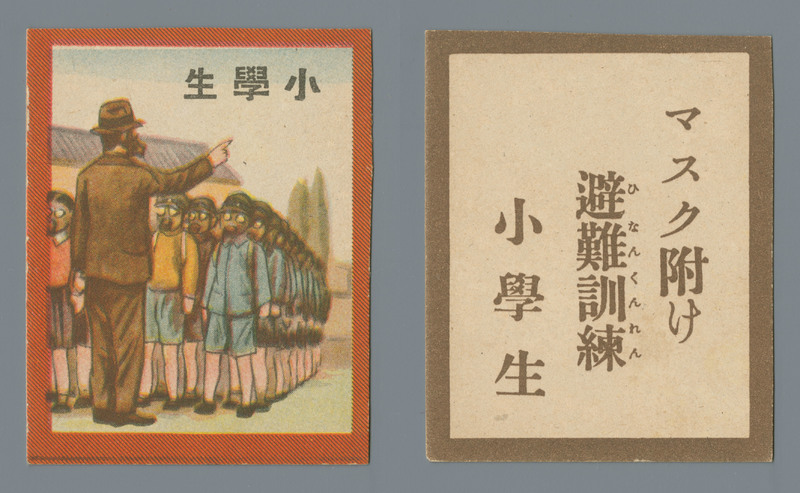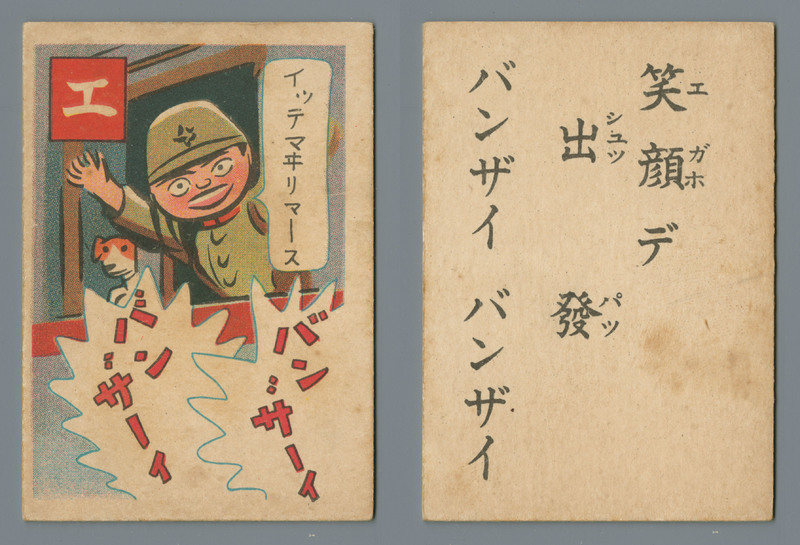Browse Exhibits
Karuta Across Time and Space
Click the above 'Karuta Across Time and Space' to begin the exhibit.
A donation made in 2014 by scholar Richard Mammana to Lafayette College included a set of 19 Japanese game cards sets from the 1930s and 1940s. Nine sets of cards are sets of the 100 Patriotic Poems, released in late 1942 by an editorial board with the backing of the Japanese government. These cards are written in kanji, the most difficult of the three Japanese scripts, and are aimed at both literate and culturally aware older readers.
The other 10 sets were a mixture of game cards from the same time period of the last 1930s and 1940s, but was clearly targeted at a much younger audience. These ten sets had shorter poems and slogans, and were all illustrated with cartoons or other drawings, and written primarily in hiragana and katakana, the two simpler, phonetic scripts used in Japanese. It is through these scripts that children are taught to read and write, before progressing to the more complex kanji characters.
Based on these observations alone, it is clear that the cards reproduced on this Omeka site were intended for a young audience still learning alphabet letters and needful of simplified information about the world around them. This exhibit will offer an introduction to the history of this type of game card in Japan, the historical context for these cards and the ways karuta has been used to encourage learning in various forms during early childhood during the period between 1931-1945.
The list of references referred to in the exhibit can be found on the 'Resources' page.
Comparing Images of Japanese and Chinese Military Subjects in Pacific War Era Karuta Cards
This exhibition includes analysis on military themed Karuta cards which were made and released in 1937, which is the year Second Sino-Japanese War (the war between Japan and China triggered by the Marco Polo Bridge Incident) began. Karuta cards are mostly played by small children in school, and it is often utilized as a part of learning materials as well. The Military County Comic Karuta set depicts the successful stories of accomplished Japanese soldier named Tecchan. It was meant to encourage Japanese school children to aspire to be Japanese soldiers and fight against the Chinese for their own country just as Tecchan does in the cards. In addition, it played a role in fostering patriotic concept in children’s minds back then. Therefore, a large portion of the cards describes idealized images of Japanese, pejorative images or caricatures of Chinese, or images that convey the idea of Japanese being superior than Chinese for propagandistic purposes.
Tecchan, the protagonist of the Karuta set, is one of the idealized Japanese depictions. In these cards, he is drawn as a childish looking soldier with favorable facial features such as rosy cheeks, adorable eyes, and confident facial expressions. Moreover, he is often depicted with a lovable dog named Chibiko, which brings in more positive atmosphere to the image of Japanese. As mentioned previously, these cards were manufactured targeting the Japanese children who would learn and absorb new concepts by playing them. It was an effective way to instill propagandistic hatred towards the Chinese and to provide the idea of patriotic duty as they grew up during the Pacific War Era.
The appearences of caricature have been seen throught out the history. According to Out of Sodeska-shi, Creating Yobo-san: Cartooning the Korean Other in Japan's Colonial Discourse by Helen J. S. Less, "cartoons played no less an important role in Japan's colonial discourse by lampooning the image of the 'barbaric' colonial other"(P32). When Korea was under the control of Japan, Koreans were depicted in a satirical way in Japanese publications. For instance, they were drawn with prominent front teeth and funny-looking glasses to be indicated as uncivilized subjects. However, these descriptions of Koreans seem to match with the descriptions of the Japanese by the Europeans even before that. In European publications, the Japanese was recognized as a "European wanna-be," "those who fail to westernize," or "babarians," which are similar to how the Japanese called the Koreans during the colonization. By projecting the condescending caricatural images of self onto the the Korean, Japan tried to remove the concept of iself being barbaric.


